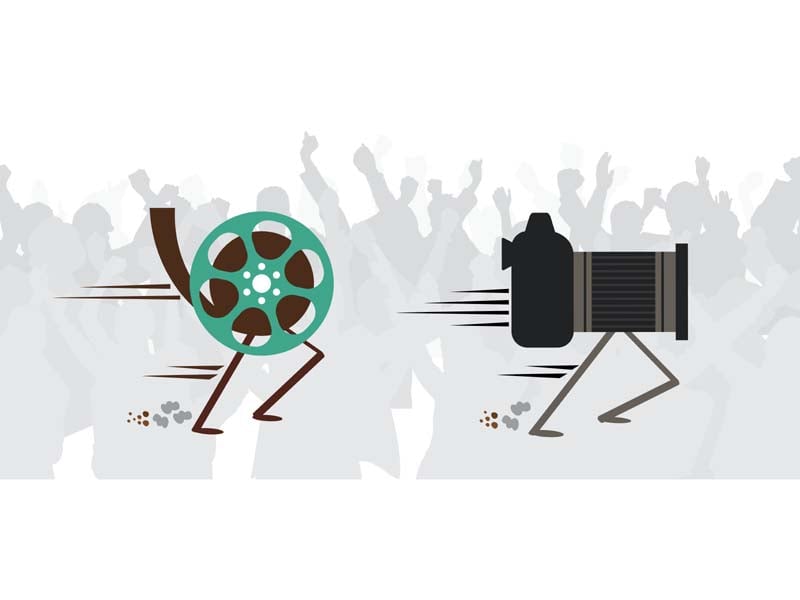
Most cinema purists will always find a certain charm in celluloid. For many directors, cinematographers and even projectionists, the allure of removing lengthy reels of film from circular metallic cans and loading them into cameras and projectors is a transcendental experience. But where the emergence of other, more physically-appealing alternatives such as cassettes, CDs and hard drives may have depleted the industry’s love affair with celluloid, there are some who refuse to shed this ‘primordial’ approach and continue to vouch for it.
‘Digital vs film’ has been a point of contention in Western cinema for a while now. However, the new and improved Pakistani film industry appears to be aloof to the debate, considering its persistent use of digital film-making. Many critics would attribute this to a lack of awareness but director Yasir Jaswal believes for an industry where output and costs are still grave concerns, getting drawn in to this debate would be unwise. “The reason is simple: cost. The process of just converting the footage from analogue to digital would cost millions,” Jaswal told The Express Tribune. “Apart from that, directors and actors also have to be accurate with their shots as they have limited space, unlike in digital films.”

Film-maker Jami echoed Jaswal’s sentiments. He highlighted how the argument between digital and analogue film-making is similar to the oil painting vs Photoshop debate. According to the Moor and Operation 021 director, the reason why few people use celluloid now is not an absence of conversion facilities but a matter of perceptions. “Mostly people who take cinema as an art form, want to preserve it and use film. That is why greats such as Christopher Nolan and Quentin Tarantino are fighting for it. Whereas in Pakistan, film-makers are looking at cinema from a commercial standpoint and hence, digital is more popular,” explained Jami.
Clarifying that there is nothing wrong with this belief, the music video director chose to look at the glass as half-full, revealing how such a modus operandi came with considerable benefits. “Apart from saving on conversion costs, it has become easier to provide a Digital Cinema Package (DCP) to cinema-owners now,” he said.
Referring to an article he had read earlier, Jami described digital as being the “distributor’s format”, the easy-to-carry nature of which spares cinema-owners and distributors from the hassle of storing large film cans in warehouses, like in the West. “It is because of this that distributors force producers to shoot on digital,” he added.
Nonetheless, it is no secret that most stakeholders of the film industry consider film to be the superior format. On the other hand, there is also no denying how vital digital film-making has been in the revival of Pakistani cinema. Weighing in on the positives of the latter, renowned cinematographer Rana Kamran indicated how the digital age has given people courage to grab a camera and start filming. “The cost of shooting on film is not something everyone can afford,” he said.

Having been part of the media fraternity for nearly two decades and working on recent hits such as Na Maloom Afraad, Kamran is well aware of the complications of shooting in analogue. According to the seasoned director of photography, celluloid is much more risky. “You don’t know the video quality until you have seen the rushes [dailies] and cannot preview your work either,” shared Kamram. He went on to say that digital film-making provides greater room for experimentation — something bound to help Pakistan in the long-run. “Not only will you see more innovative shooting and camerawork but the digital age will also help create jobs of focus-pullers and camera assistants,” he added.
Late last year, one of Pakistan’s premiere film labs, Evernew Studios, breathed its last, signalling a departure from traditional film-making for local cinema. With Khuda Kay Liye and Bol being the last two local films shot on celluloid, the practice is evidently dying out in the country. But, as mentioned earlier, the romance of celluloid remains unbridled for many such as Farouq Mengal, who recently finished shooting his debut film, Hijrat, in 35mm. Whether more auteurs choose to follow suit has yet to be seen.
Published in The Express Tribune, February 28th, 2016.
Like Life & Style on Facebook, follow @ETLifeandStyle on Twitter for the latest in fashion, gossip and entertainment.
1728297472-0/Fousey-(1)1728297472-0-405x300.webp)

1730806672-0/diddy-(37)1730806672-0-165x106.webp)
1731748155-0/BeFunky-collage-(8)1731748155-0-165x106.webp)

1731746614-0/Untitled-design-(14)1731746614-0-270x192.webp)
1731744038-0/Untitled-design-(10)1731744038-0-270x192.webp)










COMMENTS
Comments are moderated and generally will be posted if they are on-topic and not abusive.
For more information, please see our Comments FAQ